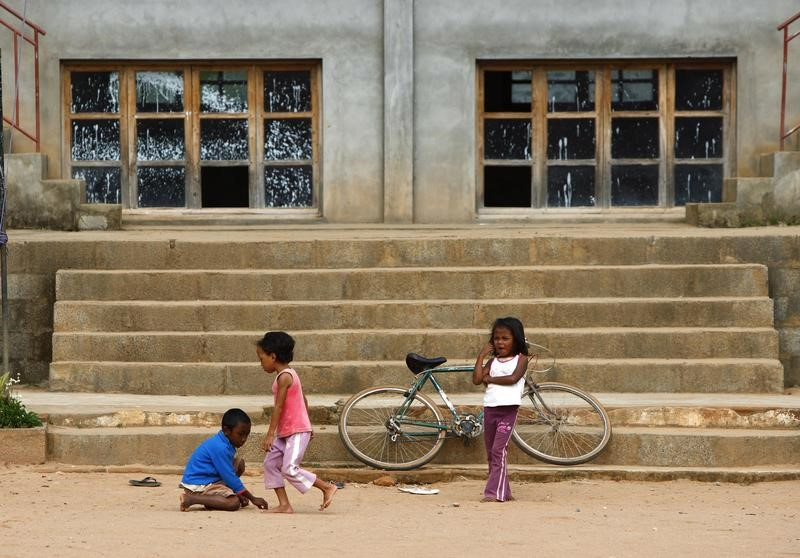The cracked red earth and sunken eyes of gaunt children, their bellies swollen from acute malnutrition, bear witness to the devastation being wrought by Madagascar’s worst drought in four decades.
As the south of the island is pushed to the brink of famine, climate change researchers say such harrowing images should serve as an alarm bell over the need for drastic action to cut planet-heating emissions and climate-proof global food systems.

Children play outside the Jesuit-run Saint Michel Fanantenana Primary School in the village of Andriampamaky, around 50 kilometres north of Madagascar’s capital city Antananarivo, on 21st April, 2012. PICTURE: Reuters/Darrin Zammit Lupi/File photo.
According to the United Nations, more than 1.14 million people in the south of the Indian Ocean country are food-insecure due to the drought, which some experts have blamed on global warming.
What caused the emergency in Madagascar and what warnings does it give about future food security in other parts of the world?
What triggered such extreme levels of hunger?
Food experts said there is no single factor behind the crisis, but that worsening droughts linked to climate change alongside a fragile food system and the economic impacts of COVID-19 have all played a role.
While droughts are not new to Madagascar, the severity of the current drought has been heightened by extreme climate shocks, they said.
“We can’t argue with the fact that this is linked to climate change and severe drought – there has been no decent rain for the last four years,” Shelley Thakral, a spokesperson for the World Food Programme, told the Thomson Reuters Foundation.
The Intergovernmental Panel on Climate Change, in a flagship UN science report, said last month Madagascar has experienced increased aridity and that human-induced climate change is the main driver of Africa’s rising surface temperature.
Humanitarian agencies say the COVID-19 pandemic has interrupted supply chains, increased unemployment and curbed access to food markets.
Subsistence farmers have been so badly affected that aid charity Medecins Sans Frontieres (Doctors Without Borders) said many have turned to foraging for insects and cactus leaves to eat.
Inadequate health facilities, poor sanitation and scarce, unsafe drinking water supplies have exacerbated an already vulnerable situation, according to the UN children’s agency, UNICEF.
Is this unprecedented?
Madagascar is facing one of the first climate-driven food security crises, said Laura Pereira, an associate professor at The Global Change Institute, a research platform at the University of the Witswatersrand in Johannesburg.
“One of the first, but certainly not the last…We’ve been seeing a lot of unprecedented things happening this year – this is one of many,” said Pereira, referring to the recent heatwaves and wildfires seen around the world.
Climate change was also found to be a key driver in the 2007 Lesotho food crisis, according to researchers from the University of Oxford.
Two years ago, Cyclone Idai battered the south-east African coastline, killing more than 1,000 people across Mozambique, Malawi and Zimbabwe while displacing thousands and destroying crops.
Cyclones and flash floods, once rare in this region, have become a regular occurrence as climate change warms oceans and causes stronger storms, while rising seas make low-lying coastlines vulnerable to them, experts say.
“Idai wiped out the east coast of Africa and also led to severe food insecurity,” Pereira said.
Can we expect more of this in other parts of the world?
Other countries are likely to experience climate-fuelled food insecurity because Madagascar is not the only one facing a severe drought, according to climate experts.
In 2020, between 720 million and 811 million people faced hunger already, in part due to the economic and supply chain effects of the pandemic, mostly in Asia, Africa and Latin America, according to the UN’s Food and Agriculture Organization.
Southern Angola is also facing extreme drought, pushing Angolans into Namibia in search of food. The Democratic Republic of Congo and the Sahel region of West Africa are also at risk, said Thakral.
“Africa is a sensitive continent when it comes to climate shocks having a severe impact on communities, so we need to make sure we prepare for the worst and have plans in place,” she said.
Other parts of the world including South Asia are also exposed to more erratic and severe heatwaves and monsoons, and it is even difficult for wealthier countries like Australia to respond to extreme droughts, said Pereira.
“[With more climate shocks], countries are more likely to look after their own needs before exporting to a global market, and this may impact countries dependent on imports,” she said.
How can we fix this?
Emergency food aid is the most pressing short-term solution, aid groups say, emphasising the need for more long-term plans that focus on innovative farming methods such as rice fortification that carries a higher nutritional value.
Madagascar’s farmers rely heavily on maize and rice which are water-intensive, so aid groups are working with officials to revise water management and introduce crops like sorghum and sweet potatoes that are more drought-resistant, said Thakral.
“We need to rethink agricultural and livestock farming…maybe we need less productivity, more heat tolerance,” said Pereira, adding that everyone can adapt their lifestyles to limit their emissions.
“Communities like Madagascar that have done nothing to contribute to climate change are on the frontlines – that is why all of us whether rural, industrialised, developed, not developed have a role to play here,” said Thakral.
She said November’s COP26 climate talks will bring together world leaders who will have to “look very closely at who is most vulnerable, what is most critical and where to invest innovation” to tackle climate change.





